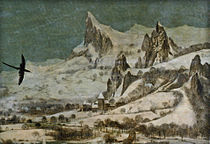The Hunters in the Snow
| The Hunters in the Snow | |
|---|---|
 | |
| Artist | Pieter Bruegel the Elder |
| Year | 1565 |
| Type | Oil on panel |
| Dimensions | 117 cm × 162 cm (46 in × 63+3⁄4 in) |
| Location | Kunsthistorisches Museum, Vienna |
The Hunters in the Snow (Dutch: Jagers in de Sneeuw), also known as The Return of the Hunters, is a 1565 oil-on-wood painting by Pieter Bruegel the Elder. The Northern Renaissance work is one of a series of works, five of which still survive, that depict different times of the year. The painting is in the collection of the Kunsthistorisches Museum in Vienna, Austria. This scene is set in the depths of winter during December/January.
Background and origins
The Hunters in the Snow, and the series to which it belongs, are in the medieval and early Renaissance tradition of the Labours of the Months: depictions of various rural activities and work understood by a spectator in Breugel's time as representing the different months or times of the year.
Description and composition
The painting shows a wintry scene in which three hunters are returning from an expedition accompanied by their dogs. By appearances the outing was not successful; the hunters appear to trudge wearily, and the dogs appear downtrodden and miserable. One man carries the "meager corpse of a fox" illustrating the paucity of the hunt. In front of the hunters in the snow are the footprints of a rabbit or hare—which has escaped or been missed by the hunters. The overall visual impression is one of a calm, cold, overcast day; the colors are muted whites and grays, the trees are bare of leaves, and wood smoke hangs in the air. Several adults and a child prepare food (preparing to singe a pig) at an inn with an outside fire. Of interest are the jagged mountain peaks which do not exist in Belgium or Holland.
The painting prominently depicts crows sitting in the denuded trees and a magpie flies in the upper centre of the scene. Bruegel sometimes uses these two species of birds to indicate an ill-omen as in Dutch culture magpies are associated with the Devil.[1]
The landscape itself is a flat-bottomed valley (a river meanders through it) with jagged peaks visible on the far side. A watermill is seen with its wheel frozen stiff. In the distance, figures ice skate, play Ice Hockey (before it became an organized sport), Kolf, and play eisstock[2] ("ice-stick", similar to curling) on a frozen lake; they are rendered as silhouettes.
Interpretation and reception
| External videos | |
|---|---|
 | |
Writing in the "opinion" section of Nature, art historian Martin Kemp points out that Old Masters are popular subjects for Christmas cards and states that "probably no 'secular' subject is more popular than ... Hunters in the Snow".[3] The painting is the subject of modernist poet William Carlos Williams's ekphrastic poem "The Hunter in The Snow".[4] Hunters in the Snow appears in Russian director Andrei Tarkovsky's film Solaris (1972).
The surviving Months of the Year cycle are:
-
The Hunters in the Snow, Dec–Jan, also known as 'Winter'
-
The Gloomy Day, Feb–Mar, also known as 'Early Spring'
-
Spring, 1565, a drawing made to be engraved and suggestive of April-May. It was apparently never painted by Bruegel himself, but after his death came dozens of versions in paint by his son and others.
-
The Hay Harvest, June–July
-
The Harvesters, Aug–Sept
-
The Return of the Herd, Oct–Nov
Popular culture
The film 24 Frames is structured in 24 chapters of "Frames" usually set in a fixed camera position filming a scene of nature or the seashore. The 'action' of each Frame is highly constrained and often focuses on either one or two animals either casually interacting or possibly vaguely interacting with one another. The opening Frame depicts the oil masterpiece by Bruegel of Hunters in the Snow and selectively animates the actions of one of the animals or birds depicted by Bruegel by superimposing movement upon Brugel's original canvas to suggest motion and life in process. [citation needed]
The painting is briefly shown in the horror film It Comes at Night.
See also
References
- ^ Kaschek, Bertram; Buskirk, Jessica; Müller, Jürgen, eds. (2018). Pieter Bruegel the Elder and Religion. Leiden and Boston: Brill. p. 265. ISBN 9789004367579. Retrieved 2 February 2021.
- ^ Wolf, Manfred (2018-10-20). "Pieter Bruegel - Meister der Beobachtung". Ober Österreich Nachrichten (in German). Retrieved 2022-10-24.
- ^ Kemp, Martin (December 2008). "Looking at the face of the Earth". Nature. 456 (18): 876. Bibcode:2008Natur.456..876K. doi:10.1038/456876a.
- ^ Williams, William Carlos. "The Hunter in the Snow". Emory University. Retrieved 13 December 2018.
Further reading
- Orenstein, Nadine M., ed. (2001). Pieter Bruegel the Elder: Drawings and Prints. The Metropolitan Museum of Art. ISBN 9780870999901. (see index)












